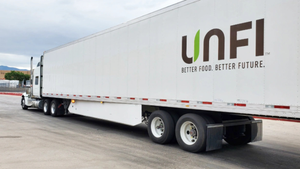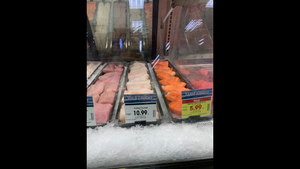COVID-19 Makes a Punishing Case for Automation in Grocery
Heavy online shopping likely to remain after crisis, heightening demand for cost and operations relief. The coronavirus crisis is likely to accelerate a slow move toward automation as online demand overwhelms operations and threatens profits.

In the two weeks since the coronavirus was a declared a pandemic, grocery retailers have been slammed with unanticipated demand for in-store and online shopping and are struggling to find enough employees to staff stores and distribution and fulfillment centers. Grocery executives are also worried that the virus could soon affect the health of their shoppers and workforce as they confront cost pressures exponentially rising with every online order.
This thorny combination of conditions—likely to intensify in the weeks ahead—appears almost certain to accelerate big shifts in how stores operate and food shopping gets done in the U.S. over the longer term. Sources predict automation and other efforts to simplify the experience and address runaway costs—only now in their earliest stages—will grow up very quickly when the crisis subsides.
“There is no doubt that people staying in and ordering online is already overwhelming every food retailer,” Gary Hawkins, CEO of the Center for Advancing Retail and Technology (CART), a Los Angeles-based platform for consumer goods innovation, told WGB. “One regional chain I talked to said their online ordering was up by 800%. There is no question this is going to drive adoption of online shopping, but stores need help managing and fulfilling orders efficiently. They need help managing curbside pickup, home delivery and last-mile solutions.”
Current observations would suggest that online grocery—even for global specialists such as Amazon and Ocado—is already more congested than a toilet-paper aisle at a Costco. WGB tried ordering an Amazon Fresh basket this week only to find no available delivery windows through early April. And Ocado, the U.K.-based online grocer, simply stopped accepting orders for at least a few days as it retooled to adjust to a higher level of demand. One customer in an online account this week described a queue of 12,000 shoppers on the platform waiting to get service.
Meeting the near-term challenges will require not only patience from consumers but adjustments from retailers—some of which are rapidly swinging into place—such as reduced store opening hours, which create time to clean and replenish stores but also pick and pack orders, and massive hiring efforts. Down the road it appears nearly inevitable that many of the shoppers trying e-commerce for the first time during the crisis will continue to shop that way—and that will require more efficiency from retailers providing it.
“Any supermarket retailer that all of a sudden is doing 20% of their sales online [is] going to hurt the bottom line,” said Hawkins.
Tipping Point for Automation
Only a handful of supermarkets in the U.S. currently use microfulfillment centers in or adjacent to existing stores, and many of those are still in initial stages. Stop & Shop, ShopRite, Big Y, Sedano’s and Albertsons, for example, are working with Takeoff Technologies at select sites; Dematic is at work on an in-store center for Meijer in Michigan; and Alert Innovations is operating an in-store robotic pick center in Salem, N.H., for Walmart and is building two additional sites. Others are en route from Fabric and AutoStore. Using automated machinery to replace the manual picking in-stores, and located close to customers to facilitate pickup and delivery, microfulfillment centers (MFCs) promise not only superior economics but also software that can help manage demand across the footprint.
“If grocers have automation technology and robotics in place already, there are strategies that can be implemented within the next couple of weeks to improve how they’re addressing a surge in online and in-store shopping,” said Mohamed Ali Vaid, VP of commercial acceleration for Dematic, an Atlanta-based logistics firm. “For example, grocers can quickly implement and connect software across storefronts to uncover and address inefficiencies in in-store and online order fulfillment, enabling them to significantly accelerate fulfillment to address this unprecedented peak in demand, now moving from heavily in-store to online now that consumers across the U.S. are settling into home quarantine directives.”
“The current environment will be a tipping point for grocery businesses to accelerate their investment in automation technology,” Vaid predicts. “Automation technology will enable grocers to create more capacity in their supply chains to better respond and weather major disruptions that increase demand, similar to what we’re seeing today.”
Steve Hornyak, chief operating officer of MFC company Fabric, estimates the events of today could double online as a percentage of total industry sales.
“Short term, we are seeing a massive increase in grocery e-commerce, with a lot of new users trying the service. Once this situation with COVID-19 settles down, we see this surge of grocery e-commerce settling in at levels significantly higher than they were just last month, even as high as double, translating to adoption well north of 5% and possibly closer to 10%—years faster than expected,” Hornyak told WGB.
A Fabric study earlier this year estimated online sales were accounting for nearly 4.5% of the U.S. grocery total. That study didn’t anticipate 10% penetration until 2024.
Cost Relief for a Coming Recession?
Beyond that, sources anticipate the economic wreckage of the current situation will almost certainly lead to a U.S. recession and other challenges in food retail, including food price deflation and that—along with the added cost pressure on retailers seeking relief from the costs of picking and packing—could spark more investment in automation.
“Everyone has to eat, even in a recession, and we are already seeing a sudden shift in consumer spending from restaurants to supermarkets driven by social distancing, and that shift will then be accelerated due to frugality as a recession takes its toll," predicts John Lert, founder of Alert Innovation, the Boston-based technology company behind automated fulfillment at some Walmart stores. “The practice of social distancing is driving an enormous surge in the adoption of grocery e-commerce across the country, and that surge will increase the penetration of online grocery, especially click-and-collect, and accelerate the need to automate at store level to enable profitable operation of a service that was formerly performed for free by the customer.”
Online grocery tends to be “sticky,” Lert added. “Many households that are now ordering online grocery for the first time out of necessity will lead to continued adoption out of choice even after people stop practicing social distancing. Consumers who were hesitant to go though the effort to download an app and take the time to build their first basket, now have a strong reason to do so and, hence, are more likely to use the service again, even after the need for social distancing recedes. Retailers that do not have to charge extra for the click-and-collect service will gain a disproportionate share of online grocery orders," he said.
Sources said they wouldn’t anticipate immediate moves as retailers hunker down to address current challenges. PJ Stafford, VP of sales and marketing for Alert, said he knew of at least two ongoing RFC processes from retailers looking at MFCs that went on hold when the crisis struck. “The retailers I have been speaking with are all hands on deck with HQ managers working in the stores, including weekends, to meet the surge in store traffic,” Stafford told WGB.
“When the current crises passes, I expect MFC planning to accelerate among grocery retailers as they look to pilot both in-store automation and larger, dark-store solutions,” he added. “While the actual installation of a system may only be a couple of months, other tasks such as building a business case, capital approval process, site engineering and renovations, site permits and more can add months to a go-live timeline.”
About the Author
You May Also Like






